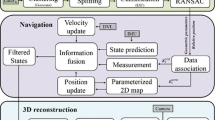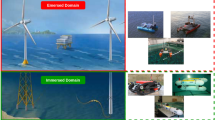Abstract
In this work, we developed a measurement system for the Gas-Autonomous Surface Vehicle (G-ASV), a successor to the micro-Autonomous Surface Vehicle (μ-ASV), to facilitate conducting ocean research. We included a Real-Time Kinematic Global Positioning System (RTK GPS) and compared the results with a regular GPS. We also incorporated stereo depth and Light Detection and Ranging (LiDAR) Cameras with Artificial Intelligence (AI) to perform object detection and mapping. The purpose was to improve the position accuracy of the ASV, conduct surveillance, and map objects such as ships within its surrounding environment while maintaining low traffic on the G-ASV’s LTE network. We proposed two methods to reduce the size of the data produced by the depth and LiDAR cameras. The first method compresses the depth image generated by the depth camera into an RGB image transmitted over the LTE network. The second method consists of converting the depth image generated by the LiDAR camera into eight equally spaced rays along the horizontal field of view of the LiDAR camera. We then mounted the system onto the G-ASV and conducted a field experiment at Tokyo Bay Marina. We significantly increased position accuracy using RTK-GPS compared to a regular GPS. Furthermore, the depth compression and recovery process results are within the margin that is considered acceptable. Therefore, we performed obstacle detection with the G-ASV using RTK, Depth Camera, and LiDAR Camera in this study and successfully mapped the obstacles on a map.














Similar content being viewed by others
References
Kawamura Y, Tahara J, Kato T, Baba S et al (2019) Control of μ-autonomous surface vehicle using sliding mode control. Sensors and Materials 31(12):4231–4245
He K, Gkioxari G, Dollár P et al (2017) Mask R-CNN. http://arxiv.org/abs/1703.06870
Dardoize T, Ciochetto N, Hong J-H et al (2019) Implementation of ground control system for autonomous multi-agents using QGroundControl. In: 2019 Workshop on Research, Education and Development of Unmanned Aerial Systems (RED UAS), Nov. 2019, pp 24–30. https://doi.org/10.1109/REDUAS47371.2019.8999717
Feng Y and Wang J (2008) GPS RTK performance characteristics and analysis. J Glob Position Syst 7(1):1–8. https://www.scirp.org/html/376.html
Koubaa A, Allouch A, Alajlan M et al (2019) Micro air vehicle link (MAVLink) in a nutshell: a survey. http://arxiv.org/abs/1906.10641
Karney C (2012) Geoid height. Sourceforge.net. Accessed: Dec 07, 2021. https://geographiclib.sourceforge.io/1.18/geoid.html
Karney C (2012) Geographic library. sourceforge.net. Accessed: Dec 07 2021. https://geographiclib.sourceforge.io/1.18/index.html
Šakan D, Kos S, Ban BD et al (2021) On linear and circular approach to GPS data processing: analyses of the horizontal positioning deviations based on the adriatic region IGS observables. Data (Basel) 6(2):9. https://doi.org/10.3390/data6020009
Bass J (2020) ImageZMQ. Accessed: Dec. 09, 2021. https://github.com/jeffbass/imagezmq
Sonoda T and Grunnet-Jepsen A. Depth image compression by colorization for Intel® RealSenseTM Depth Cameras. Accessed: Dec 09, 2021. https://dev.intelrealsense.com/docs/depth-image-compression-by-colorization-for-intel-realsense-depth-cameras
Xiao Z-S (2011) A Multi-scale Structure Similarity metric for image fusion qulity assessment. Int Conf Wavelet Anal Pattern Recogn 2011:69–72. https://doi.org/10.1109/ICWAPR.2011.6014491
Girshick R (2015) Fast R-CNN. In: IEEE International Conference on Computer Vision (ICCV), Dec., pp 1440–1448. https://doi.org/10.1109/ICCV.2015.169
Paszke A et al (2019) PyTorch: an imperative style, high-performance deep learning library. In: Advances in neural information processing systems. pp 8024–8035. http://papers.neurips.cc/paper/9015-pytorch-an-imperative-style-high-performance-deep-learning-library.pdf. Accessed 23 Mar 2022
Dutta A and Zisserman A (2019) The VIA annotation software for images, audio and video. In: Proceedings of the 27th ACM International Conference on Multimedia, Oct., pp 2276–2279. https://doi.org/10.1145/3343031.3350535
Lin T-Y et al (2014) Microsoft COCO: common objects in context. Accessed 10 Sept 2021
Weiss K, Khoshgoftaar TM, Wang D (2016) A survey of transfer learning. Journal of Big Data 3(1):9. https://doi.org/10.1186/s40537-016-0043-6
Pixabay. https://pixabay.com (accessed Apr 25, 2022)
timeanddate (2022) Past Weather in Tokyo, Japan. https://www.timeanddate.com/weather/japan/tokyo/historic?month=3&year=2022 (accessed Apr 27, 2022)
Google Inc., Google Earth. https://earth.google.com/. Accessed 23 Mar 2022
Karney CFF (2013) Algorithms for geodesics. J Geodesy 87(1):43–55. https://doi.org/10.1007/s00190-012-0578-z
Acknowledgements
This study was possible with the support of the River Fund from The River Foundation, Japan. It was also possible with the help of Professor Etsuro Shimizu from the Tokyo University of Marine Science and Technology for his assistance with an electric boat (The Raicho) during the field test at Tokyo Bay Marina. We are very thankful to them all, and we sincerely appreciate their support.
Author information
Authors and Affiliations
Corresponding author
Additional information
Publisher's Note
Springer Nature remains neutral with regard to jurisdictional claims in published maps and institutional affiliations.
About this article
Cite this article
Gideon, K., Makoto, M., Fujii, S. et al. Development of a measurement system for gas-autonomous surface vehicle to map marine obstacles using stereo depth and LiDAR cameras. Artif Life Robotics 27, 842–854 (2022). https://doi.org/10.1007/s10015-022-00796-1
Received:
Accepted:
Published:
Issue Date:
DOI: https://doi.org/10.1007/s10015-022-00796-1




